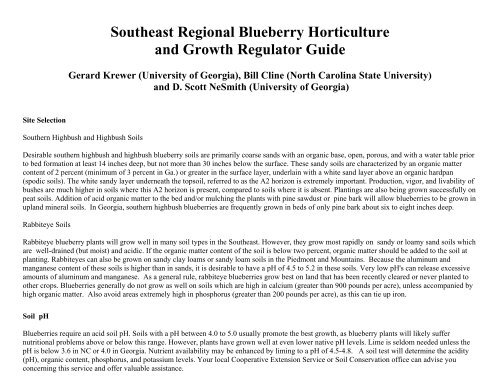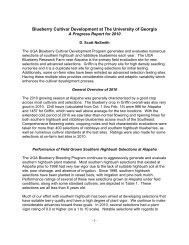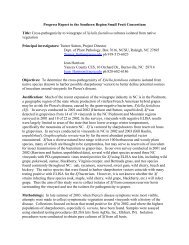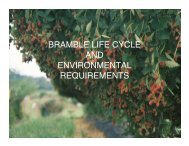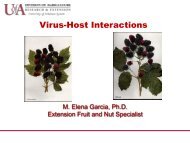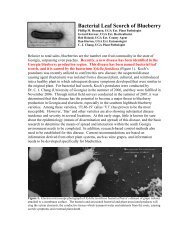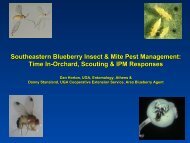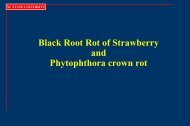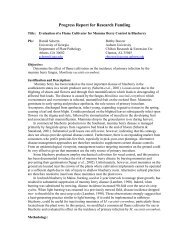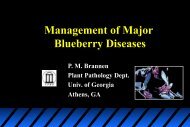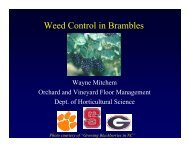Southeast Regional Blueberry Horticulture and Growth Regulator ...
Southeast Regional Blueberry Horticulture and Growth Regulator ...
Southeast Regional Blueberry Horticulture and Growth Regulator ...
You also want an ePaper? Increase the reach of your titles
YUMPU automatically turns print PDFs into web optimized ePapers that Google loves.
Soil MoistureSoil moisture is a critical factor in blueberry production. <strong>Blueberry</strong> bushes are very shallow rooted <strong>and</strong> will not tolerate either extreme drought orprolonged periods of excessive water in the root zone. <strong>Blueberry</strong> roots also lack root hairs. Consequently, they require a well-drained soil but onewhich has a continuous moisture supply. In some areas this condition can be maintained by regulating the water table at 14 to 30 inches below thesurface with ditches, canals, etc. In all other locations, supplemental irrigation is needed.<strong>Blueberry</strong> TypeHighbush blueberries grow well in the desirable blueberry soil conditions described above. Rabbiteye <strong>and</strong> southern highbush blueberries will too;however, rabbiteyes may exhibit excessive vigor in such soils, especially in North Carolina. The rabbiteye blueberry is more widely adapted todifferent soil conditions than the highbush <strong>and</strong> southern highbush blueberry. However, poor plant growth of rabbiteye blueberry has been associatedwith soil pH levels above 5.4. Rabbiteye blueberries will not tolerate the cold climate of the higher mountains in North Carolina, but have performedwell in the Georgia mountains. Southern highbush, <strong>and</strong> to a greater extent rabbiteye, are also more drought <strong>and</strong> heat resistant than highbush. All ofthese blueberries may be grown in less desirable soils by the addition of organic matter to the planting hole/bed, supplying supplemental irrigation,<strong>and</strong> by mulching around the plants with 4 to 6 inches of aged sawdust or pine bark mulch.Important Cultural PracticesTraining Young Plants (1 to 3 Years of Age) – If vigorous, well-rooted two-year-old bed-grown plants are set, they will need cutting back by upto ½ of their total height at or shortly after planting to remove fruit buds <strong>and</strong> all twiggy growth If container grown plants are used, it may necessary to“beat out” the roots to correct pot binding. Again, plants should be cut back about ½ to balance the top <strong>and</strong> root system. Pruning should beconducted in the second year in the field to stimulate strong new growth on selected canes <strong>and</strong> remove flower buds. Do not permit plants youngerthan three years of age to bear more than a modest amount of fruit, or the onset of the commercially productive period will be delayed. A largebearing area is best established in the shortest possible time by removing all flower buds during the first two years.Winter Pruning of Bearing Southern Highbush <strong>and</strong> Highbush Plants (over 3 to 4 years of age) – Using a set sequence with each bush ensuresthat pruning is uniform across the planting. Normally this type pruning is carried out during the winter since it is easy to see what needs to beremoved at this time. However, in South Georgia, this type of pruning can also be conducted immediately after harvest (early June).1. Sucker <strong>and</strong> head back -- Remove all low-spreading branches <strong>and</strong> suckers that have sprouted too far away from the crown of the bush. Cut off(head back) the tallest upright "bull shoots" to the desired height to keep the bush from growing too tall. Summer pinching of excessivelyvigorous canes can be used to control the height of the bush <strong>and</strong> turn these canes into productive fruiting shoots. Be sure to leave a few strong,upright basal shoots each year, to replace the older canes you will be removing.2. Cane Renewal or making large "shaping cuts" — Select <strong>and</strong> completely remove the oldest canes if they are weak, particularly if in the centerof the plant. Remove dead canes <strong>and</strong> cross-overs. Essentially, you have then automatically selected the remaining, more vigorous canes to bear
your crop next season <strong>and</strong> the following season. However, do not remove more the 15% of the canopy in this procedure. Depending on thenumber of canes in the bush this is typically one or two canes removed per bush.3. Brush Wood Removal. On the remaining canes, systematically "thin out" flower buds by removing the shorter, thinner shoots(“brushwood”), leaving enough of the thick shoots to bear the crop <strong>and</strong> make new growth. Only experience can tell you how many shoots aparticular variety of a particular age can carry <strong>and</strong> still perform well. It is probably better in most instances to prune too lightly than too heavily.Lighter pruning is usually practiced as the plant grows older because it can carry more "wood" successfully due to a larger root system.4. If severe summer hedging is conducted, it is not necessary to make large shaping cuts or systematically thin out remaining canes. Summerhedging promotes thick vigorous canes with reduced numbers of flower buds.Winter Pruning Bearing Rabbiteye Plants – Rabbiteye blueberries over five years old usually benefit from cane renewal pruning. Cane renewalpruning involves removing about 15% of the canopy by cutting one to three of the oldest canes each winter about one or two inches from the crown,with loppers. Also during this process, remove as much dead wood as feasible. If mechanical harvest is being used, try to narrow the crown as muchas practical. Attempt to narrow the bush to one foot wide at the 18 inch level. This is where the “fish scales” of the mechanical harvester normallycontact the bush. On rabbiteye cultivars such as Climax, that have few canes, remove only a portion of a cane each year. Flower bud numbers <strong>and</strong>fruit set on rabbiteye blueberries is often lower than on highbush. For this reason, it is seldom necessary to do detailed h<strong>and</strong> pruning on rabbiteyes.Post Harvest or Summer Hedging – Post-harvest hedging is an optional practice that can be used to reduce winter pruning costs, adjust crop load<strong>and</strong> timing, <strong>and</strong> manage leaf spot diseases. Sickle bar or flail mowers can be used. Flail mowers are preferred because they are faster, have a widerrange of cutting angles <strong>and</strong> heights, <strong>and</strong> serve to both remove <strong>and</strong> chop (mulch) the prunings in a single pass. Flail mowers tend to shatter morecanes, but this has not resulted in more disease in North Carolina, <strong>and</strong> actually seems to stimulate more new shoots. Severe flail mowing ofsouthern highbush in Georgia is not recommended, as this has resulted in severe disease problems. For small operations, or in high densitybeds, hedging can be done with heavy-duty, h<strong>and</strong>-held gasoline shrub hedgers. A roof-top cut down each side of the row at about 45 to 55 degreesfrom the horizontal is recommended over a flat top cut.With rabbiteye blueberries the growing season remaining after harvest is relatively short, so it is important that hedging be conducted as soon afterharvest as possible. Mid to late July is best for hedging, but the procedure should be finished no later than the first week in August in North Carolina<strong>and</strong> mid-August in south Georgia. Normally only about 6 inches of regrowth occurs on rabbiteyes in the year of hedging, so the hedging cut shouldbe very moderate. No more than about 18 inches of bush height should be removed in one year. Avoid cutting into the main bearing area of thecanopy when possible. Ideally, start hedging in the year the bushes reach a height of seven feet if h<strong>and</strong> harvested <strong>and</strong> 7-9 feet if machine harvested.Remove cut debris from the bush after hedging to avoid disease problems. Fertilize <strong>and</strong> water well after hedging. Flowers on new growth producedafter hedging will bloom later than the rest of the bush <strong>and</strong> may require treatment for thrips in south Georgia.For highbush blueberries, most cultivars finish ripening in late May or early June in south Georgia <strong>and</strong> southeast North Carolina, therefore, a moresevere hedging can be conducted. If plants are growing in single rows in the field at 9 to 12 feet between rows, mature bushes can be “roof-top”hedged back immediately after harvest with the top of the “roof” cut at 4 to 5 feet. Select pruning height based on bush vigor <strong>and</strong> the length of thegrowing season remaining. Normally about 1.5 to 2.5 feet of regrowth occurs after harvest if the bushes have good vigor <strong>and</strong> are well fertilized <strong>and</strong>watered. In North Carolina, yields may be reduced the year following hedging on most cultivars except ‘O’Neal’ <strong>and</strong> ‘Reveille’. However, bud mite<strong>and</strong> fruit rot problems are reduced by hedging. Many growers in North Carolina summer roof-top hedge one year followed by winter cane renewal
the next (18 months later). The post-harvest growing season in south Georgia is about one month longer than North Carolina, so annual post-harvesthedging of mature vigorous southern highbush growing in single rows may be feasible in some situations. Do not hedge highbush in single rowsexcessively, as a large canopy (about six feet in height after regrowth) is needed for high production.For southern highbush growing in south Georgia in high density pine bark beds (typical spacing of 5 feet between rows), hedging should beconducted in late May. A roof-top cut with the top at 2.5 to 3.5 feet is recommended. Select pruning height based on bush vigor <strong>and</strong> the length of thegrowing season remaining. Normally about 2 to 3 feet of regrowth occurs after harvest if the bushes have good vigor <strong>and</strong> are well fertilized <strong>and</strong>watered. If a cultivar has marginally low numbers of flower buds (‘Star’ for example), a second hedging or tipping can be conducted when the newgrowth is 12 to 18 inches in length. This should be conducted no later than August in south Georgia. This normally promotes more branching <strong>and</strong>increases the number of flowers. It is also important on ‘Star’ to leave sufficient numbers of “spring” shoots. These shoots will have a much higherflower bud density than fall shoots.Fertilizer recommendations for Georgia:RabbiteyesBearing rabbiteye blueberries growing in loamy s<strong>and</strong> soils with moderate amounts of organic matter (1-2%) usually require about 60 pounds ofnitrogen per year. Apply about 30 pounds of nitrogen per acre near bud break <strong>and</strong> 30 pounds after harvest. Additional nitrogen may be needed onvery poor soils, but less on high organic matter soil (over 3%). Phosphorus <strong>and</strong> potassium should be applied according to soil tests. In general, 10-10-10 has been a good blend for rabbiteyes in Georgia. DAP (18-46-0) is a good source of phosphorus in situations where phosphorus is low.Highbush in Soil or Amended StripsBearing southern highbush in soil or pine bark amended strips usually need between 80 <strong>and</strong> 120 pounds of nitrogen per year in south Georgia, splitinto a minimum of four to five applications. Make a minimum of two applications in the spring <strong>and</strong> others after harvest. Typical times ofapplication in south Georgia are mid to late Feb., late March or early April , early June, mid-July, <strong>and</strong> late Aug. Apply 30 to 40 pounds of nitrogenpre-harvest as follows: 20 pounds of nitrogen at bud break <strong>and</strong> 10-20 pounds 4 to 6 weeks later. Avoid fertilizing with nitrogen during harvest inmost situations. After harvest about 50 to 80 pounds of nitrogen should be applied, at the rate of 15-20 pounds per acre for each application.Typically about 50 pounds of phosphate <strong>and</strong> potassium are applied per year, but this should be monitored by soil <strong>and</strong> leaf analysis.Highbush in Bark BedsBearing southern highbush in pine bark beds usually need 120 to 200 pounds of nitrogen per year depending on many factors such as the age of thebark, irrigation practices, type of fertilizer used (regular, slow release or controlled release) <strong>and</strong> severity of summer hedging. In south Georgia,apply a minimum of three applications in the spring <strong>and</strong> four applications after harvest if a slow release fertilizer is not used. Typical times ofapplication are mid-Feb., mid-March, early April, early June, early July, early Aug. <strong>and</strong> early Sept. using about 20 pounds of nitrogen per acre ateach application. Avoid fertilizing with nitrogen during harvest in most situations. Pine bark does not hold phosphorus <strong>and</strong> potassium well.Phosphorus <strong>and</strong> potassium requirements are estimated to be about 50-100 pounds per acre per year, but adjust based on media <strong>and</strong> leaf analysis.Watch for excessive boron <strong>and</strong> manganese levels. Do not apply premium grade fertilizer (contains micronutrients) if these are too high. InGeorgia, send in pine bark samples to the UGA Lab as a “Greenhouse /Nursery” Test.
Plant Tissue AnalysisIn order to monitor plant nutrient status, tissue can be sent to the UGA Lab for analysis. Just after harvest, collect 50 to 100 leaves per sample fromthe mid-portion of the shoot. Collect samples from across the field, pulling off just a few leaves at a time. Sample varieties separately. To preparesamples, leaves should be washed in clear water to remove most pesticides <strong>and</strong> dust, air dried <strong>and</strong> placed in a clean paper bag. Send leaves in as soonafter sampling as possible. Values for nutrient level needs are listed in the table below:ELEMENTSuggested Critical Nutrient Levels in Highbush <strong>and</strong> Rabbiteye <strong>Blueberry</strong> LeavesDEFICIENCYBELOWSt<strong>and</strong>ard Range forHighbush <strong>and</strong> (Rabbiteye)Minimum Maximum EXCESS ABOVENitrogen (N) 1.70% 1.80 (1.20) 2.10 (1.70) 2.50Phosphorus (P) 0.10 0.12 (0.08) 0.40 (0.17) 0.80Potassium (K) 0.30 0.35 (0.28) 0.65 (0.60) 0.95Calcium (Ca) 0.12 0.40 (0.24) 0.80 (0.70) 1.00Magnesium (Mg) 0.08 0.12 (0.14) 0.25 (0.20) 0.45Sulfur (S) 0.10 0.12 (NA) 0.20 (NA) NAManganese (Mn) 23 ppm 50 (25) 350 (100) 450Iron (Fe) 60 60 (25) 200 (70) 400Zinc (Zn) 8 8 (10) 30 (25) 80Copper (Cu) 5 5 (2) 20 (10) 100Boron (B) 20 30 (12) 70 (35) 200
Fertilizer recommendations for North Carolina:Propagation bedsApply 1 lb. diammonium phosphate (18-46-0) dissolved in 4 gallons water per 100 sq. ft. of bed beginning when cuttings are well-rooted (July 1-15)<strong>and</strong> repeat every 2 weeks until mid-August.First yearAfter the first flush of growth apply 40 to 80 lbs. of 14-28-14 per acre <strong>and</strong> repeat every 4 to 6 weeks until mid-August. Extend application intervalduring dry periods until rainfall has totaled 4 inches. Based on 1360 plants per acre.Second yearDouble first year amount when new growth begins in the spring. Follow the first year timing <strong>and</strong> rate schedule for the rest of the season.Bearing plantsApply 100 to 150 lbs of 14-28-14 prior to blossoming <strong>and</strong> an additional 50 to 75 pounds 4 to 6 weeks later (early May). On s<strong>and</strong>y soils or if moregrowth is desired, apply 50 pounds ammonium nitrate after harvest. Apply 50 pounds per acre of diammonium phosphate 18-46-0 in mid-August tomaintain plant vigor if phosphorus is low or leaching has been severe.Adjustments for rabbiteye blueberriesThe above recommendations are based on tests <strong>and</strong> responses of highbush blueberries. Rabbiteye blueberries require less fertilizer, especiallynitrogen. For the first 3 years, rabbiteye can be fertilized the same as highbush in order to get maximum growth. Once plants reach about 5 feet tall,the rates should be reduced. On soils with more than 2% organic content, little or no nitrogen is required. When bushes reach 5 feet tall on soils withmore than 2% organic content, apply 50 to 100 pounds per acre of 14-28-14 prior to blossoming. Make additional applications only if more growthor better bush color is desired. Rabbiteye bushes with foliage that is a medium green (slightly yellow-green) are often more productive than bushesthat are a deep green. The deep-green bushes produce excessive vegetative growth (shoots) <strong>and</strong> fewer flower buds. Rabbiteye bushes respondrapidly to nitrogen fertilization if the leaf color gets too yellow. Green color will often return within 10 to 14 days after applying 50 pounds per acreof ammonium nitrate. The mid-August application of diammonium phosphate is generally beneficial also for rabbiteye in order to stimulate a healthyroot system for the winter. Rabbiteye bushes require more adjustments in fertilization depending upon soil organic content <strong>and</strong> rainfall than do
highbush plants. In some tests, on soils with more than 2% organic content, production has been equal or greater with no fertilization than with anyfertilizer combination.NOTE: The 14-28-14 fertilizer is a blend of diammonium phosphate, ammonium nitrate (33-0-0) <strong>and</strong> potassium chloride (0-0-60). Otherformulations are available but this one is probably the most desirable since no filler is required. The same ingredients can be blended into a 14-14-14analysis if soil phosphorus is in the medium or high range. Use proportionally more fertilizer if an analysis lower than 14-14-14 or 14-28-14 is used.Apply actual copper at the rate of 1 pound each year or 5 pounds once every 5 years. Take soil samples at least once each year to determinephosphorus level <strong>and</strong> changes in pH.Lime at the rate of 500 lbs/acre (about ½ lb/bush) has given a positive response on soils when the pH was below 3.6. Avoid excessively liming since1000 lbs/acre has been detrimental in all cases.
Overview of <strong>Blueberry</strong> <strong>Growth</strong> <strong>Regulator</strong>s(Read detailed information before purchase or use)ProblemPoor Spring leaf development <strong>and</strong>delayed flowering of some southernhighbush <strong>and</strong> rabbiteyes, delayed harvestPoor fruit set of rabbiteye blueberries inpoor pollination situations or years;Poor fruit set following partial freezedamage of rabbiteye flowersManagementOptionsDormex(50%hydrogencyanamide)Gibberellicacid -ProGibb 4%liquidconcentrateor GibGro 4LS or Gibbex4%Amount ofFormulationper AcreTypically1 ½%Dormex plus1 pint peracre of nonionicsurfactant in50 gallons ofwater24-32oz./acre (4%gibberellicacid) or 24-32 gramsgibberellicacid/acreapplied twice(total of 48-64 oz./acre inmost cases)Effectiveness (+)or Importance (*) REI PHI Comments++++ 72certain cultivars hours NA++++ 12hours40daysNot recommended for use in NorthCarolina. This is a material that must beused with caution.Enclosed cab tractor required forapplication.Will kill flower buds if applied after budswell. Application must be based on buddevelopment. Typical application dates forsouthern highbush in south Georgia are lateDec. or early Jan. Rabbiteyes applicationsare usually in late Jan. or early Feb. Useonly on a small scale until you gainexperience with the material. Do not applywithin 14 days of oil application or within30 days of copper fungicide application.First application: When at least 40-50% ofthe blooms are open. About 10% of theflower petals should have fallen. Secondapplication: 10-18 days later.1. min. of 40 gal. water/acre.2. Add surfactant.3. If solution is alkaline (pHgreater than 8.0), lower thepH with a buffering agent.4. Apply at night or duringslow drying conditions
ProblemCultivars blooming too early <strong>and</strong>suffering freeze damage, two cultivars notblooming at the same time for crosspollinationManagementOptionsSuper Boll,55.4%ethephonAmount ofFormulationper Acre400 ppmsolution; 9.2ounces per100 gallonsplus 1 pintper acre ofnon-ionicsurfactantEffectiveness (+)or Importance(*)++++some cultivarssuch as ClimaxREI PHI Comments48hoursNAFor use only in Georgia.Test on a limited basis before wide spreaduse. May delay harvest.Applied in the Fall for bloom delay the nextSpring to help avoid Spring freeze damage.Can also be used on an early-bloomingcultivar to help synchronize its bloom witha later blooming cultivar (i.e. Climax treatedin a Climax / Tifblue field will help improvebloom overlap.)First application in S. Ga.: mid October.Second application: early NovemberGood coverage is necessary, apply 50-100gallons per acre.
Dormex to Enhance Fruit Ripening of Certain Southern Highbush <strong>and</strong> Rabbiteye BlueberriesResponse: If properly used, Dormex can stimulate more rapid leaf development in the spring, resulting in more concentrated ripening on the firsttwo harvests on blueberry cultivars with poor spring leaf development in south Georgia. Both increased number of leaf bud breaks <strong>and</strong> earlierleaf emergence occurs on poor leafing blueberry cultivars in response to Dormex. Dormex also promotes defoliation of old leaves, reducing leafdisease carry over.Flower buds at stage 3 of bud development or beyond (see gibberellic acid bud stage section) are extremely vulnerable to chemical burn <strong>and</strong>/orinjury when using Dormex. Normally advances bloom by a few days, slightly increasing the risk of freeze injury. Most commonly used by southernhighbush growers with overhead irrigation for freeze protection.Material: Dormex -50% hydrogen cyanamideTiming: Timing of Dormex applications is extremely important in order to achieve the desired response <strong>and</strong> to avoid flower bud injury. Applyduring the dormant season after significant winter chilling has been received, but before significant flower bud swelling occurs. Apply before asignificant number of flower buds reach stage 3 (see flower bud chart in gibberellic acid recommendations). Timing must be based on flowerdevelopment, however, generally optimum time of application in lower south Georgia has been early January on low chilling requirement southernhighbush. Generally, the best timing for rabbiteyes such as ‘Climax’ has been late January or early February. But again, plants must be examinedfor their stage of development. If excess floral bud swell <strong>and</strong> floral bud break has occurred, chemical injury to buds is highly possible.Rate of Material: Typically 1.5%to 2% Dormex with 0.25% non-ionic surfactant in a minimum 50 gallons of water per acre. The 1 ½% rate isthree quarts of Dormex plus one pint of surfactant in 50 gallons of water. The 2% rate is ½ gallon of Dormex plus one pint of surfactant in 50gallons of water. Most growers in Georgia use 1 ½%. On some cultivars with very tight flower buds <strong>and</strong> where more complete defoliation of oldleaves is desired, 2% can be used. Read the label carefully before use.Additional Remarks: Dormex is a moderately toxic material <strong>and</strong> is registered for application only with closed cab tractors. Read the label carefullybefore use.Do not consume alcohol the day before or after application, as this makes your body more sensitive to Dormex (cyanamide “flush”-rapid heart beat<strong>and</strong> skin reddening). Do not enter or allow worker entry into treated areas during the restricted entry interval (REI) of 72 hours.Dormex is highly corrosive to equipment. Clean up thoroughly after application.
Avoid drift. Dormex may be toxic to green plants such as winter vegetable crops <strong>and</strong> shrubs; it is also toxic to pets, wild animals <strong>and</strong> livestock. Usea spray pressure of 50 psi to reduce drift.Flower buds sprayed at stage three or beyond may be killed by Dormex, especially at concentrations of 1.5% to 2%. However, when applied in thecorrect “window” of bud development (bud stage 1 <strong>and</strong> 2), 1.5% to 2% usually gives a much better response than 1%.Direct spray nozzles to the area with flower buds.Do not apply within 14 days of an oil spray or within 30 days of a copper fungicide spray.Apply during dry weather. Slow drying may enhance Dormex activity <strong>and</strong> cause more phytotoxicity if the buds are swelling.Dormex may advance flowering by several days, slightly increasing the risk of freeze damage.Dormex is not needed on cultivars with good leaf development such as ‘Sharpblue’, ‘Emerald’ <strong>and</strong> ‘Brightwell’. Dormex reponse has been erratic on‘O’Neal’.Do not apply to cultivars with “puffy” flower buds such as ‘Sharpblue’. Dormex may wick between the bud scales <strong>and</strong> kill even dormant flowerbuds.Gibberellic Acid as an Aid for Fruit Set of Rabbiteye BlueberriesAdditional considerations <strong>and</strong> precautions for using Gibberellic Acid:1. Gibberellic acid is expensive, but has been effective in improving fruit set on bushes affected by poor pollination. Poor pollination can be theresult of cultivars not blooming together, cultivars which have low pollen compatibility, low bee activity, high night temperatures during bloom, lowtemperatures during bloom, excessively rainy weather during bloom, <strong>and</strong> damage to the blooms from insects such as thrips. Many large fields insouth Georgia will benefit from gibberellic acid application in most years.2. Good results can be obtained with two applications of 24-32 oz./acre (48-64 oz./acre total) in 40 gallons of water per acre, spraying both sides ofthe bush each time. Another successful method is cultivar directed treatment (CDT). Where two varieties with different bloom dates are plantedtogether (i.e. 'Climax' with 'Tifblue') this is the best method. Using CDT, the first <strong>and</strong> second application of gibberellic acid are directed toward thefirst variety to bloom (i.e. ‘Woodard’ or ‘Climax’). Some gibberellic acid will also reach the adjacent variety (i.e. ‘Tifblue’), helping the early
flowers to set. The third <strong>and</strong> fourth sprays are directed toward the later blooming variety (i.e. ‘Tifblue’). The last ‘Woodard’ or ‘Climax’ flowers toopen will benefit from spray drift from ‘Tifblue’. The total applied during the season is normally 48-64 oz. acre.3. Apply gibberellic acid in about 40 gals. of water per acre. Since gibberellic acid activity is concentration-dependent (150 p.p.m. or greater activeingredient is best) at least 0.6 oz.of ProGibb should be used per gallon of finished spray (i.e. 24 oz. in 40 gal., 30 oz. in 50 gal., or 36 oz.in 60 gal.).4. Although common non-ionic surfactants can be used, it is recommended that X-77, Silwet L-77, Kinetic, or Flood be used with gibberellic acid.Follow label rates carefully. Silwet L-77 is used at the rate of only 3.2 oz./100 gal. of spray. Caution should be used in trying other surfactants,because they could burn blueberry blooms.5. In past years, only night applications of gibberellic acid were recommended. However, several experiments in 1995 showed comparable fruit setoccurred for both early day <strong>and</strong> night applications. In any case, it is best to apply gibberellic acid during periods of slow drying such as at night, inthe late evening or very early in the morning.6. Gibberellic acid should be compatible with most fungicides, but a small-scale trial is recommended to make sure settling or clabbering is not aproblem. The spray solution pH should be checked to make sure the pH is not too alkaline (pH 8.0 or above). If the pH is 8.0 or above, add abuffering agent.7. Do not apply within 40 days of harvest.8. If possible, do not apply if rain is forecast within 12 hours.9. Do not apply to bushes in a low state of vigor.10. Excessive applications may reduce flowering the following year by setting more fruit than the bush can properly mature. This is especially true ifthe bushes are in a low state of vigor. Do not apply to young bushes (i.e. 3 years old or less) since heavy fruiting may delay establishment.11. Some cultivars such as ‘Alapaha’, ‘Brightwell’ <strong>and</strong> ‘Powderblue’ usually set a good crop if planted with compatible cultivars for crosspollination. They seldom need applications of gibberellic acid unless bee activity is low or the blooms are damaged by spring freezes.12. Southern highbush blueberries often set more fruit than they can properly mature. Gibberellic acid can increase this problem.13. Part of the yield increase often seen with gibberellic acid is from smaller-sized, seedless or nearly seedless berries which ripen later in the season.If you are mechanically harvesting for the frozen market, this is not a problem, but it could pose a problem for h<strong>and</strong> picking of fresh fruit.
14. <strong>Blueberry</strong> fruit set <strong>and</strong> fruit size under natural conditions is determined in large part by number of seeds in the fruit. Low seed counts result insmaller, later ripening fruit. Gibberellic acid can set fruit, but will not fully substitute for total lack of seeds. Fruit set with a combination ofgibberellic acid <strong>and</strong> some seeds develop better fruit size, so bee pollination is important even in fields treated with gibberellic acid. Growers shoulduse honey bees (min. 2 strong hives per acre) if there are not large numbers of honeybees <strong>and</strong> wild bees such as bumble bees <strong>and</strong> southeasternblueberry bees present in the blueberry field. Most large fields do not have enough bees, so honeybees should be imported.15. Although flowers are most receptive to fruit set with gibberellic acid at stage 5 (elongated but not yet open) <strong>and</strong> 6 (open), seedless fruit set justwith gibberellic acid are smaller in size than partially seeded fruit set with the help of gibberellic acid. Allow at least 40 to 50% of the flowers toopen <strong>and</strong> be worked by bees before gibberellic acid application. About 10% of the petals (corollas) should have fallen. Apply a second application ofgibberellic acid 10 to 18 days later.1 = no visible swelling, bud scales completely enclose the flowers;2 = visible swelling of bud, scales separating, flowers still completely enclosed;3 = bud scales separated, apices of flowers visible;4 = individual flowers distinguishable, bud scales abscised;5 = individual flowers distinctly separated, corollas elongated but closed;6 = corollas completely exp<strong>and</strong>ed <strong>and</strong> open;7 = corollas dropped. Adapted from J. M. Spiers, 1978, J. Amer. Soc. Hort. Sci. 103 (4): 452-454.Fig. 1. Stages of flower bud development in rabbiteye blueberries:Gibberellic acid as an Aid for Fruit Set of Rabbiteye Blueberries Following Slight Freeze InjuryResponse: Increase fruit set of flowers with slight freeze damage.Material: Gibberellic acid -- ProGibb 4% liquid concentrate or GibGro 4 LSSituations <strong>and</strong> timing: The use of gibberellic acid for fruit set following freeze damage to rabbiteye blueberries is a fairly recent discovery. Field<strong>and</strong> laboratory experiments indicate it may be used in several situations. Actual damage suffered during a freeze depends on many factors
including stage of bloom, cultivar, wind, low temperature, <strong>and</strong> duration of low temperature. Blossom temperatures during radiation freezescan be 2-3 o F lower than protected thermometer temperatures.As a general rule, blossom temperatures in the range of 26-32F will cause partial flower damage to rabbiteye flowers at stage 5 <strong>and</strong> 6. If the freezeoccurs during full bloom, this calls for the first gibberellic acid application soon after the freeze event. Apply a second application of gibberellic acid10 to 18 days later.Temperatures below 26 o F are likely to cause total death of flowers at stage 5 <strong>and</strong> 6. In this case, application of gibberellic acid starts when theslightly freeze damaged stage 3 <strong>and</strong> 4 flowers develop into stage 5 <strong>and</strong> 6. Note that freeze damaged flowers may never open properly or be receptiveto bee pollination, so an application of gibberellic acid should be applied when a large percentage of the damaged blooms reach stage 5 <strong>and</strong> a stageequivalent to 6 in age. If the weather is warm after a freeze this is often about one week after the freeze. Apply a second application of gibberellicacid 10 to 18 days later.Ethephon for Bloom Delay on ‘ Climax’ <strong>and</strong> Certain other <strong>Blueberry</strong> Cultivars in GeorgiaResponse: Spring bloom delay if applied the previous Fall. Length of delay will vary with cultivar, number of applications <strong>and</strong> rate of ethephonapplied. Delays of seven to 14 days are likely to occur with ‘Climax’, with seven to ten days being typical. Response has been variable on somesites. Trial on a small scale on your farm with your own cultivars before adopting widespread use.Material: ethephon: Superboll (55.4% a.i.)Timing: First application: mid-OctoberSecond application: early NovemberIf possible, apply when temperatures are in the range of 60 to 80 degrees F. One application will provide most of the bloom delay, a secondapplication will lengthen the bloom delay.Rate of Material: Use 4.6 ounces per 50 gallons or 9.2 ounces per 100 gallon of finished spray solution. This will produce a 400 ppm solution ofethephon. Add a non-ionic surfactant at the rate of one pint per acre. Good coverage is needed for this material to work. Apply a minimum of 50 to100 gallons of water per acre depending on bush size.
Remarks: Fruit ripening will be delayed. Length of delay of fruit ripening is related to improved crop load <strong>and</strong> delayed flowering.Ethephon has been tested for a number of years on a number of bluerberry cultivars in Georgia. No plant damage or flower bud damage has beenobserved, but growers are cautioned to mix the material at the proper rate. Only healthy plants should be sprayed.In several trials, flower bud numbers have been increased. If a cultivar sets excessive flower buds already, use only a trial basis. Cultivars which havedemonstrated appreciable bloom delay with ethephon are:‘Climax’, FL86-19(“V1”), ‘O’Neal’,’Sharpblue’, <strong>and</strong> ‘Woodard’. Cultivars which have exhibited minimal bloom delay with ethephon are:‘Bluebelle’ <strong>and</strong> ‘Tifblue’ (zero to two days delay in bloom).To improve bloom synchronization of ‘Climax’ planted with ‘Tifblue’ or ‘Brightwell’, spray only the ‘Climax’. In a trial with an airblast sprayer,drift of ethephon spray from the treated rows of ‘Climax’ had minimal effect on bloom of ‘Brightwell’ where a good st<strong>and</strong> (solid row) of ‘Climax’was present. Adjust spray nozzles so primarily ‘Climax’ is sprayed.


